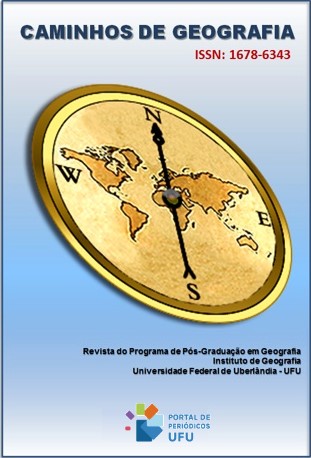GEOINFORMATION AND PARTICIPATORY MAPPING TECHNOLOGIES APPLIED TO TRADITIONAL TERRITORY USE PLANNING – SOUTHEAST OF BRAZIL
DOI:
https://doi.org/10.14393/RCG249465769Keywords:
Traditional Peoples and Communities, Territorial management, Social CartographyAbstract
The management of the traditional territory is an essential procedure for the survival of Traditional Peoples and Communities (culturally differentiated groups). Cartography, through geoinformation and participatory mapping technologies, is constantly called by these groups to help them face the adversities related to regularization and territorial management. Little has been explored yet about the use of Cartography as an instrument for planning the use of the territory, which is one of the main stages of territorial management. The work analyzed the potential of participatory maps and geoinformation technologies in the planning processes for the proper use and re-appropriation of traditional territories. The experiences lived in the Território Geraizeiro Veredas Vivas, in Rio Pardo de Minas – MG were used. The participatory map created to plan the use of the land in this territory ensured territorial planning consistent with the local way of life and revealed particularities related to sustainable production and environmental conservation. The mapping of invasions helped in monitoring irregular uses and occupations and in diagnosing the skills of local residents regarding the use of geotechnologies. It is suggested the implementation of training in geoinformation technologies so that these individuals will have greater autonomy and continuity in the mapping processes aimed at territorial management.
Downloads
Downloads
Published
How to Cite
Issue
Section
License
Copyright (c) 2023 Matheus Vinicius Ferreira, Marcos Esdras Leite, Carlos Alberto Dayrell

This work is licensed under a Creative Commons Attribution-NonCommercial-NoDerivatives 4.0 International License.
Autores que publicam nesta revista concordam com os seguintes termos: a) Autores mantém os direitos autorais e concedem à revista o direito de primeira publicação, com o trabalho licenciado sob a Creative Commons Atribuição-NãoComercial-SemDerivações 4.0 Internacional. b) Autores têm permissão e são estimulados a publicar e distribuir seu trabalho online (ex.: em repositórios institucionais ou na sua página pessoal), já que isso pode gerar alterações produtivas, bem como aumentar o impacto e a citação do trabalho publicado. c) Em virtude de aparecerem nesta revista de acesso público, os artigos são de uso gratuito, com atribuições próprias, em aplicações educacionais e não-comerciais.











